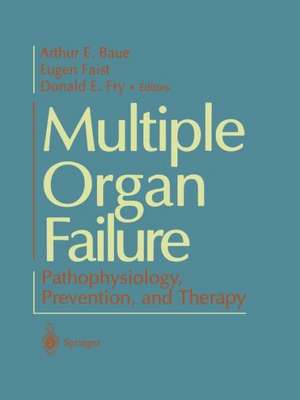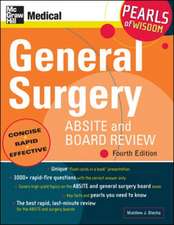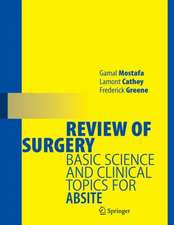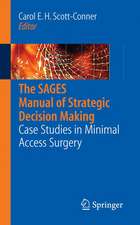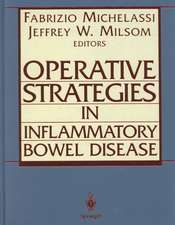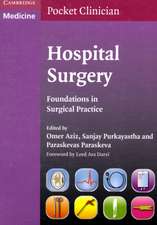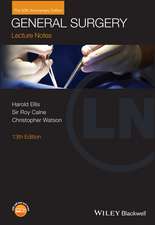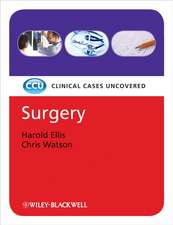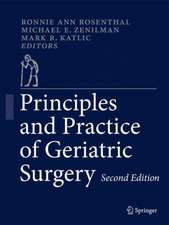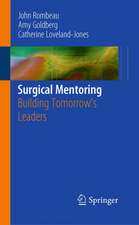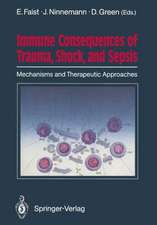Multiple Organ Failure: Pathophysiology, Prevention, and Therapy
Editat de Arthur E. Baue, Eugen Faist, Donald Fryen Limba Engleză Paperback – 13 oct 2012
| Toate formatele și edițiile | Preț | Express |
|---|---|---|
| Paperback (1) | 1458.33 lei 6-8 săpt. | |
| Springer – 13 oct 2012 | 1458.33 lei 6-8 săpt. | |
| Hardback (1) | 1435.96 lei 38-44 zile | |
| Springer – 7 iun 2000 | 1435.96 lei 38-44 zile |
Preț: 1458.33 lei
Preț vechi: 1535.09 lei
-5% Nou
Puncte Express: 2187
Preț estimativ în valută:
279.04€ • 292.13$ • 230.90£
279.04€ • 292.13$ • 230.90£
Carte tipărită la comandă
Livrare economică 05-19 aprilie
Preluare comenzi: 021 569.72.76
Specificații
ISBN-13: 9781461270492
ISBN-10: 1461270499
Pagini: 736
Ilustrații: XXII, 712 p.
Dimensiuni: 210 x 280 x 39 mm
Greutate: 1.62 kg
Ediția:Softcover reprint of the original 1st ed. 2000
Editura: Springer
Colecția Springer
Locul publicării:New York, NY, United States
ISBN-10: 1461270499
Pagini: 736
Ilustrații: XXII, 712 p.
Dimensiuni: 210 x 280 x 39 mm
Greutate: 1.62 kg
Ediția:Softcover reprint of the original 1st ed. 2000
Editura: Springer
Colecția Springer
Locul publicării:New York, NY, United States
Public țintă
ResearchDescriere
Inflammation in itself is not to be considered as a disease . . . and in disease, where it can alter the diseased mode of action, it likewise leads to a cure; but where it cannot accomplish that solitary purpose . . . it does mischief - John Hunter, A Treatise on the Blood, ITfIlammation, and Gunshot Woundr (London, 1794)1 As we reached the millennium, we recognized the gap between our scientific knowledge of biologic processes and our more limited clinical capabilities in the care of patients. Our science is strong. Molecular biology is powerful, but our therapy to help patients is weaker and more limited. For this reason, this book focuses on the problems of multiple organ failure (MOF), multiple organ dysfunction syndrome (MODS), and systemic inflammatory response syndrome is, patients who have severe injuries; require major, (SIRS) in high-risk patients, that overwhelming operations; or have serious illnesses requiring intensive care; patients who have diseases elsewhere, in other organs or systems, that limit their capabilities to survive a new insult; and patients who are elderly or at high risk for sepsis or other complications. These are the patients who need our help. They need the advances in science, in molecular biology, immunology, pathophysiology, biochemistry, genetics, high technology, and other areas of maximum support at the bedside. These advances could potentially have the greatest impact on improving patient care.
Cuprins
I Development of SIRS, MODS, and MOF.- 1. History of MOF and Definitions of Organ Failure.- 2. SIRS, MODS, and the Brave New World of ICU Acronyms Have They Helped Us?.- 3. Systemic Inflammatory Response and Multiple Organ Dysfunction Syndrome: Biologic Domino Effect.- 4. Risk Factors for MOF and Pattern of Organ Failure Following Severe Trauma.- 5. Risk and Setting for Multiple Organ Failure in Medical Patients.- 6. Epidemiology, Risk Factors, and Outcome of Multiple Organ Dysfunction Syndrome in Surgical Patients.- II Mechanisms of SIRS and Organ Failure.- 7. Systemic Inflammation After Trauma, Infection, and Cardiopulmonary Bypass; Is Autodestruction a Necessary Evil?.- 8. Cardiopulmonary Bypass for Cardiac Surgery;An Inflammatory Event: Can It Be Modulated?.- 9. Gut: Clinical Importance of Bacterial Translocation, Permeability, and Other Factors.- 10. Mcrocirculatory Arrest Theory of SIRS and MODS.- 11. Infection, Bacteremia, Sepsis, and the Sepsis Syndrome: Metabolic Alterations, Hypermetabolism, and Cellular Alterations.- 12. Ischemia and Reperfusion as a Cause of Multiple Organ Failure.- 13. Endotoxin in Human Disease and Its Endogenous Control.- 14. Untimely Apoptosis in Human SIRS, Sepsis, and MODS.- 15. Immunosuppression with Injury and Operation and Increased Susceptibility to Infection.- III Mediators and Effectors.- 16. Emerging Evidence of a More Complex Role for Proinflammatory and Antünflammatory Cytokines in the Sepsis Response.- 17. Counterregulation of Severe Inflammation: When More Is Too Much and Less Is Inadequate.- 18. Reactive Oxygen Species in Clinical Practice.- 19. Nitric Oxide as a Modulator of Sepsis: Therapeutic Possibilities.- 20. Mast Cells.- 21. Eicosanoids.- 22. Platelet-Activating Factor.- 23. Therapeutic Complement Inhibition.- 24. Leukocyte—Endothelial Cell Interactions: Review of Adhesion Molecules and Their Role in Organ Injury.- IV Prevention and General Therapy.- 25. Care of Injured Patients in the Field, During Transport, and in the Emergency Department.- 26. Intensive Care Monitoring.- 27. Peritonitis: Management of The Patient with SIRS and MODS.- 28. Hypothermia—Coagulopathy—Acidosis Syndrome: When to Operate/When to Stop Operating.- 29. Early Definitive Fracture Fixation with Polytrauma: Advantages Versus Systemic/Pulmonary Consequences.- 30. Abdominal Compartment Syndrome.- 31. SIRS and MODS: Indications for Surgical Intervention?.- 32. Nosocomial Infections in the ICU.- 33. Modulation of the Hypermetabolic Response After Trauma and Burns.- V Specific Remote Organ Failures.- 34. Circulation.- 35. Effect of Inflammatory Conditions on the Heart.- 36. Lung.- 37. Renal Function and Dysfunction in Multiple Organ Failure.- 38. Metabolic Depletion and Failure: Muscle Cachexia During Injury and Sepsis.- 39. Immunomodulation of Cell-Mediated Responses: Is It Feasible?.- 40. Central Nervous System Failure: Neurotrauma Trials.- 41. Stress Gastritis: Is It a Disappearing Disease?.- 42. Gut and the Immune System: Enteral Nutrition and Immunonutrients.- 43. Disseminated Intravascular Coagulation.- 44. Refunctionalization of the Gut.- 45. Liver: Multiple Organ Dysfunction and Failure.- 46. Liver: Hepatic Support and the Bioartificial Liver.- VI Therapeutic Horizons.- 47. Laboratory Markers to Support Early Diagnosis of Infection and Inflammation.- 48. Endotoxin Antagonists.- 49. Blood Purification Therapy to Prevent or Treat MOF.- 50. Antithrombin III and Tissue Factor Pathway Inhibitor: Two Physiologic Protease Inhibitors of the Coagulation System.- 51. Rationale for Glucocorticoid Treatment in Septic Shock and Unresolving ARDS.- 52. Pathophysiologic and Clinical Importance of Stress-Induced Th1/Th2 T Cell Shifts.- 53. Pathophysiologic and Clinical Role of Interferon-? and Its Release Triggering Cytokines IL-12 and IL-18.- 54. Interleukin-11: Potential Therapeutic Activity in Systemic Inflammatory States.- 55. Minimal Surgical Procedures to Decrease the Stress Response and New Potential Therapeutic Agents.- 56. Wound Healing: Physiology, Clinical Progress, Growth Factors, and the Secret of the Fetus.- 57. Problems with Magic Bullets: Future Trials and Multiagent Therapy.- 58. Maximizing Oxygen Delivery and Consumption: In Whom and for Whom?.- 59. Gut Decontamination: Prevention of Infection and Translocation.- 60. Myocardial Depression: Is It Clinically Relevant?.- 61. Infection: Cause or Result of Organ Failure?.- 62. Hypertonic Solutions.- 63. Blood Substitutes.- 64. Growth Factors G-CSF and GM-CSF: Clinical Options.- 65. Anabolic Effects of Growth Hormone in Critically Ill Patients.- 66. Immunoglobulin Therapy: Where Does It Stand Clinically?.- 67. Horizons in the Anesthetic Care of Injured, Operated, and Stressed Patients.- 68. Integrative Biology and Genetic Variability: MODS’ Next Frontiers.- 69. Are We Making Progress in Preventing and Treating MOF?.- 70. Ethical Considerations of MODS, SIRS, and MOF.- 71. Socioeconomic Impact of Multiple Organ Failure.- 72. Future Directions in the Treatment of SIRS and MODS.- 73. Summary and Overview: What Does the Future Hold?.
Recenzii
"As multiple organ dysfunction remains the significant cause of ICU mortality, this textbook, the leading secondary source on this problem, is an important contribution." Doody's Reviews
